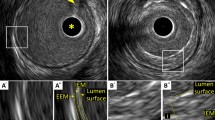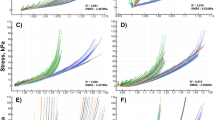The objective of this paper was to evaluate the ability of the peak systolic velocity ratio (PSVR) and pressure drop (ΔP) to detect and grade multiple stenoses in lower limb mimicking arteries. Numerical simulations and experiments in vascular phantoms allowing ultrasound duplex scanning and pressure measurements were used to investigate simple and double stenotic arterial segments. Inter-stenotic distance, severity of the distal stenosis, flow rate and flow profile (steady or pulsatile) were the tested parameters. The three-dimensional simulations considered the turbulent two-equation Wilcox model. Agreements were observed between the experimental and numerical results for ΔP and PSVR. The maximum PSVR along the artery was shown to be mainly influenced by the severity of the most important stenosis. However, mutual interactions of both stenoses on hemodynamics were noted. By using the clinical PSVR threshold used to diagnose critical lesions (PSVR ≥ 2), its longitudinal evolution along the artery poorly reflected the length of the lesion or the impact of surrounding stenoses. This investigation confirms the interaction between adjacent stenoses on hemodynamics and its impact on the Doppler ultrasound index PSVR.












Similar content being viewed by others
REFERENCES
Ahmed, S. A., and D. P. Giddens. Pulsatile flow studies with laser Doppler anemometry. J. Biomech. 17:695–705, 1984.
Allard, L., G. Cloutier, L. G. Durand, et al. Limitations of ultrasonic duplex scanning for diagnosing lower limb arterial stenoses in the presence of adjacent segment disease. J. Vasc. Surg. 19(4):650–657, 1994.
Allard, L., G. Cloutier, and L. G. Durand. Doppler velocity ratio measurements evaluated in a phantom model of multiple arterial disease. Ultrasound Med. Biol. 21(4):471–480, 1995.
Allard, L., G. Cloutier, Z. Guo, et al. Review of the assessment of single level and multilevel arterial occlusive disease in lower limbs by duplex ultrasound. Ultrasound Med. Biol. 25(4):495–502, 1999.
Aly, S., M. P. Jenkins, F. H. Zaidi, et al. Duplex scanning and effect of multisegmental arterial disease on its accuracy in lower limb arteries. Eur. J. Vasc. Endovasc. Surg. 16:345–349, 1998.
Ang, K. C., and J. Mazumdar. Mathematical modelling of triple arterial stenoses. Australas. Phys. Eng. Sci. Med. 18(2):89–94, 1995.
Back, M. R., A. N. Bowser, D. C. Schmacht, et al. Duplex selection facilitates single point-of-service endovascular and surgical management of aortoiliac occlusive disease. Ann. Vasc. Surg. 16(5):566–574, 2002.
Bergamini, T. M., C. M. Tatum Jr, C. Marshall, et al. Effect of multilevel sequential stenosis on lower extremity arterial duplex scanning. Am. J. Surg. 169(6):564–566, 1995.
Cloutier, G., G. Soulez, S. D. Qanadli, et al. A multimodality vascular imaging phantom with fiducial markers visible in DSA, CTA, MRA and ultrasound. Med. Phys. 31(6):1424–1433, 2004.
De Smet, A. A., E. J. Ermers, and P. J. Kitslaar. Duplex velocity characteristics of aortoiliac stenoses. J. Vasc. Surg. 23(4):628–636, 1996.
Ghalichi, F., X. Deng, A. De Champlain, et al. Low Reynolds number turbulence modeling of blood flow in arterial stenoses. Biorheology 35:281–294, 1998.
Hoskins, P. R.. A comparison of single- and dual-beam methods for maximum velocity estimation. Ultrasound Med. Biol. 4:583–592, 1999.
Idu, M. M., J. D. Blankenstein, P. De Gier, et al. Impact of color-flow duplex surveillance program on infrainguinal vein graft patency: A five-year experience. J. Vasc. Surg. 17:42–52, 1993.
Jager, K. A., D. J. Phillips, R. L. Martin, et al. Noninvasive mapping of lower limb arterial lesions. Ultrasound Med. Biol. 11(3):515–521, 1985.
Jones, S.A.. Fundamental sources of error and spectral broadening in Doppler ultrasound signals. Crit. Rev. Biomed. Eng. 21(5):399–483, 1993.
Latornell, D. J., A. Pollard. Some observations on the evolution of shear layer instabilities in laminar flow through axisymmetric sudden expansion. Phys. Fluids 29(9):677–681, 1986.
Lee, T. S. Steady laminar fluid flow through variable constrictions in vascular tube. J. Fluids Eng. 116:66–71, 1994.
Leng, G. C., M. R. Whyman, P. T. Donnan, et al. Accuracy and reproducibility of duplex ultrasonography in grading femoropopliteal stenoses. J. Vasc. Surg. 17(3):510–517, 1993.
Matignon, Y. Échographie-Doppler dans l’artériopathie oblitérante des membres inférieurs. ©Agence Nationale d'Accréditation et d'Évaluation en Santé. Juin 2002. Available at: http://www.anaes.fr/anaes/Publications.nsf/nPDFFile/RA_LILF-5EHJD7/$File/echodoppler.rap.pdf. Accessed on October, 2003.
Moneta, G. L., R. A. Yeager, R. Antonovic, et al. Accuracy of lower extremity arterial duplex mapping. J. Vasc. Surg. 15(2):275–284, 1992.
Ojha, M., R. S. C. Cobbold, K. W. Johnston, et al. Pulsatile flow through constricted tube: An experimental investigation using photochromic methods. J. Fluid Mech. 203:173–197, 1989.
Pincombe, B., J. Mazumdar, I. Hamilton-Craig. Effects of multiple stenoses and post-stenotic dilatation on non-Newtonian blood flow in small arteries. Med. Biol. Eng. Comput. 37(5):595–599, 1999.
Ramaswami, G., A. Al-Kutoubi, A. N. Nicolaides, et al. The role of duplex scanning in the diagnosis of lower limb arterial disease. Ann. Vasc. Surg. 13(5):494–500, 1999.
Ranke, C., A. Creutzig, and K. Alexander. Duplex scanning of the peripheral arteries: correlation of the peak velocity ratio with angiographic diameter reduction. Ultrasound Med. Biol. 18(5):433–440, 1992.
Rickey, D. W., P. A. Picot, D. A. Christopher, et al. A wall-less vessel phantom for Doppler ultrasound studies. Ultrasound Med. Biol. 21(9):1163–1176, 1995.
Sacks, D., M. L. Robinson, D. L. Marinelli, et al. Peripheral arterial Doppler ultrasonography: diagnostic criteria. J. Ultrasound Med. 11(3):95–103, 1992.
Seeley, B. D., and D. F. Young. Effect of geometry on pressure losses across models of arterial stenoses. J. Biomech. 9:439–448, 1976.
Sensier, Y., T. Hartshorne, A. Thrush, et al. The effect of adjacent segment disease on the accuracy of colour duplex scanning for the diagnosis of lower limb arterial disease. Eur. J. Vasc. Endovasc. Surg. 12(2):238–242, 1996.
Siouffi, M., V. Deplano, and R. Pélissier. Experimental analysis of unsteady flows through a stenosis. J. Biomech. 31(1):11–19, 1997.
Steinman, A. H., J. Tavakkoli, J. G. Myers, et al. Sources of errors in maximum velocity estimation using linear-array doppler systems with steady flow. Ultrasound Med. Biol. 5:655–664, 2001.
Ubbink, D. T., M. Fidler, and D. A. Legemate. Interobserver variability in aortoiliac and femoropopliteal duplex scanning. J. Vasc. Surg. 33:540–545, 2001.
van Dreumel, S. C., and G. D. C. Kuiken. Steady flow through a double converging-diverging tube model for mild stenoses. J. Biomech. Eng. 111:212–221, 1989.
Varghese, S. S., and S. H. Frankel. Numerical modeling of pulsatile turbulent flow in stenotic vessels. J. Biomech. Eng. 125:445–460, 2003.
Wilcox, D. C. Turbulence Modeling for CFD. DCW Industries Inc., 1993.
Young, D., and F. Tsai. Flow characteristics in models of arterial stenoses—II. Unsteady flow. J. Biomech. 6:547–559, 1973.
Young, D., N. Cholvin, R. Kirkeeide, and A. Roth. Hemodynamics of arterial stenoses at elevated flow rates. Circ. Res. 41(1):99–107, 1977.
Youngchareon, W., and D. Young. Initiation of turbulence in models of arterial stenoses. J. Biomech. 12:185–196, 1979.
ACKNOWLEDGMENTS
This work was supported by a merit fellowship for post-doctoral research of the Quebec Ministry of Education (to C.B.), a studentship from the Natural Sciences and Engineering Research Council of Canada (to. B.L.), and a grant from the Canadian Institutes of Health Research (#MOP-53244 to G.C., L.G.D., G.S.). Drs. Soulez and Cloutier are respectively recipient of a clinical research scholarship award and of a national scientist award from the Fonds de la Recherche en Santé du Québec. Dr. Bertolotti performed this work at the Institut de Recherches Cliniques of Montreal, and then with the Équipe Biomécanique Cardiovasculaire, EGIM, at the C.N.R.S. (I.R.P.H.E.) UMR 6594, Marseille, France. The authors acknowledge Philips Medical System (Dr. Helen Routh) for the loan of the ultrasound system used in this study.
Author information
Authors and Affiliations
Corresponding author
Rights and permissions
About this article
Cite this article
Bertolotti, C., Qin, Z., Lamontagne, B. et al. Influence of Multiple Stenoses on Echo-Doppler Functional Diagnosis of Peripheral Arterial Disease: A Numerical and Experimental Study. Ann Biomed Eng 34, 564–574 (2006). https://doi.org/10.1007/s10439-005-9071-7
Received:
Accepted:
Published:
Issue Date:
DOI: https://doi.org/10.1007/s10439-005-9071-7




